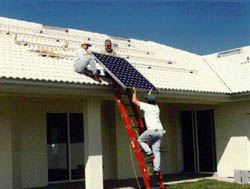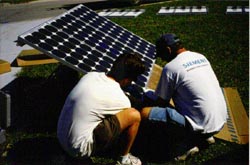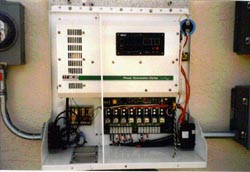
![]()

FSEC researchers developed the specifications for a utility interactive photovoltaic system to be used during this study. Hutton Communications, Inc was selected as the systems integrator and was tasked with providing a ready-to-install kit. Hutton selected the system components including the photovoltaic modules and power conditioner. They provided assurance of compatibility between the various products and supplied the balance of system components, which included schematics for the electrical connections, junction boxes, fuse blocks, and lightning suppressors.
Sizing the Photovoltaic Array:
The PV generation system was sized to provide power that would offset most of the daytime household electrical loads. Simulation models provided an estimate of the usage and the PV array output. Based on the predicted loads for a peak day, it was determined that a 4kW solar array should be installed. The simulations indicated an array this size would match the anticipated electrical demand of the house for approximately eight hours on hot summer day. However, the available south-facing roof area did not meet the size requirements of a 4kW array. It was determined that the array would be split into two sub-arrays, one facing south and the other facing west. This setup allows the total number of modules installed to remain the same, but significantly changes the power generation profile. The models indicated that the west-facing array would produce slightly less power than the south array over the year. However, predictions also indicated the west sub-array would generate appreciable power later in the day when residential loads are greater and, after the output of the south sub-array had diminished.

The photovoltaic system in this study will be owned and maintained by the electric utility company (Lakeland Electric & Water) and the power generated is supplied to the utility side of the meter. The output of the system is monitored by the utility company to evaluate the system performance and to troubleshoot problems. Systems installed such as this one increases the capacity of a service provider and can help reduce the total operating hours required for fuel-burning generators.
Photovoltaic Modules:
Siemens SP75 solar modules were selected for installation on the roof of the house. These single crystalline modules have a maximum power rating of 75W and have a selectable voltage of 12V or 6V. Bypass diodes are installed in each module to minimize the power loss due to partial shading. The photovoltaic arrays were installed in panels, each comprised of three modules connected in series. Thirty-six modules or 12 panels make up the south-facing sub-array and 18 modules or six panels face west.
Inverter/Power Conditioner:

The PV system is extensively monitored with instruments to evaluate the performance and compare the actual power output with the simulation models. This system and others like it will be part of a pilot program to determine the feasibility of the solar rooftop systems as distributed generators for utility companies in Florida.
